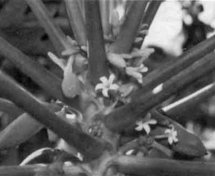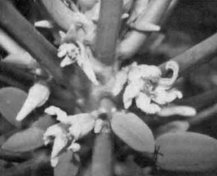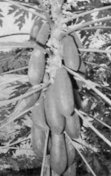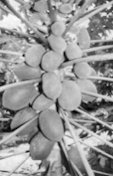
Papaya
Scientific name: Carica papaya
Family: Caricaceae
Papaya is a native of tropical America where it has been cultivated
for a very long time. It is known as 'papaw' in some countries. The
Spanish explorers discovered it in Panama and North Western South
America around the sixteenth century, and its cultivation began in the
Far East by the end of the eighteenth century. Today, it is grown
widely throughout the tropics and cultivation has also been carried out
in some of the subtropical regions. Besides, it is one of the most
common fruit trees planted on small farms and backyards in Singapore
and Malaysia.
It is a sappy, softwood evergreen plant with latex
vessels spread throughout. The trunk is straight, normally unbranched
and may grow to a height of 2-10 metres. It has a smooth surface but
clearly bears the scars where old leaves have fallen off. A tuft of
hand-shaped leaves spiral round the top of the trunk.
The leaves
are large, palmate and deeply-lobed, growing on long petioles that are
attached to the trunk. They are smooth and bluish-green on the upper
surface but pale green and much ridged by the veins underneath.
Papaya
plants are usually dioecious, with either male or female flowers. These
are then referred to as male or female plants respectively. However,
hermaphrodite or bisexual trees that produce complete flowers also
occur.
Inflorescences arise in the axils of the leaves. The male
flowers grow on long hanging panicles while female and complete flowers
occur singly or, in cluster close to the stems on female and
hermaphrodite trees. The female and complete flowers are larger in size
than the male flowers. The flowers are sweet-smelling, with waxy, dull,
creamy yellow petals. The sex of the plant is determined only when it
starts to flower.
 |  | Complete flowers
(hermaphrodite tree) | Female flowers |
The
fruits are large berries which vary greatly in size, shape and flavour.
The weight of each fruit may range from 0.5 kg to 9 kg, depending on
varieties. Fruits produced from hermaphrodite flowers are either
cylindrical or pear-shaped, whereas female flowers give rise to
elliptical or more round fruits. The skin is smooth and thin. It is
green at first, then changes to a yellow or orange colour as the fruit
ripens. The flesh of the fruit also varies in colour from creamy yellow
to orangey-red, the latter of which is in greater demand in our local
market. The central cavity is hollow, with numerous tiny, dark grey
seeds attached to its wall. However, seedless fruits occur too.
Papaya
is a short-lived tree which grows at a fast rate in fertile,
well-drained soil. Propagation is by seeds which take about 2 weeks to
germinate, and from then on two leaves emerge each week. Under optimum
conditions, the plant will fruit in the first year of planting. The
fruits take four to six months to mature depending on climate and
variety.
The tree fruits continuously all year round and remains
in prime condition for two to three years. Its economic life comes to
an end after the third year, as the yield declines and the fruits
diminish in size.
A fruit is considered ready for harvest when
the latex of the fruit becomes watery. For local consumption, it is
best to pick the fruit when the green colour is halfway changed into
yellow. But for distant transport, it is advisable to pick sooner,
after the blossom end has turned colour. Fruits are stored to soften up
fully at room temperature before table consumption. There are several
varieties available locally. Among the better known ones, the
yellow-fleshed type includes Hawaii Solo and Honey Dew, while the
red-fleshed type includes a local dwarf variety and the Pacific Strain
from Guam.
 |  | Fruits
(hermaphrodite
tree) | Fruits
(female tree) |
The
fleshy part of the fruit contains carbohydrate, protein, calcium and
abundant vitamins A and C. Papaya fruit is considered a mild laxative
by many locals. Ripe fruits are mainly eaten as fresh fruit or blended
with milk to make a refreshing drink. The immature fruits may be
pickled in sugar or vinegar, or cooked and used as a vegetable.
The
flavour of the fruit is usually very delicate, but there are also
tasteless ones. Some of the fruits may even have an unpleasant smell.
Papaya
has other commercial importance apart from its value as a fruit. The
milky latex from the plant contains the enzymes which have
protein-digesting and milk-clotting properties. It is obtained from the
sap which oozes from a cut made in the bark, and from immature fruits.
After drying, it forms a powder commercially known as papain. Papain is
used medicinally in cases of weak digestion and also as a meat
tenderiser. Besides this, the latex is also used in the manufacture of
chewing-gum and in leather-tanning, as well as in the textile industry
where it helps to prevent shrinkage of wool and silk.
Back to
Papaya Page
|
